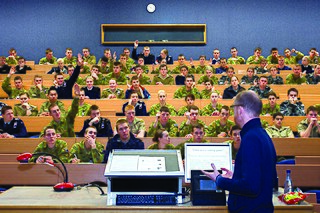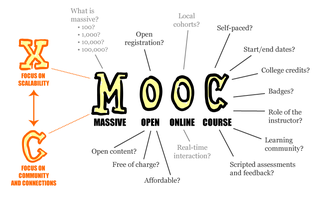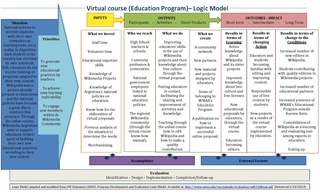Related Research Articles

Distance education, also known as distance learning, is the education of students who may not always be physically present at a school, or where the learner and the teacher are separated in both time and distance. Traditionally, this usually involved correspondence courses wherein the student corresponded with the school via mail. Distance education is a technology mediated modality and has evolved with the evolution of technologies such as video conferencing, TV, and internet. Today, it usually involves online education and the learning is usually mediated by some form of technology. A distance learning program can be completely distance learning, or a combination of distance learning and traditional classroom instruction. Other modalities include distance learning with complementary virtual environment or teaching in virtual environment (e-learning).

Active learning is "a method of learning in which students are actively or experientially involved in the learning process and where there are different levels of active learning, depending on student involvement." Bonwell & Eison (1991) states that "students participate [in active learning] when they are doing something besides passively listening." According to Hanson and Moser (2003) using active teaching techniques in the classroom create better academic outcomes for students. Scheyvens, Griffin, Jocoy, Liu, & Bradford (2008) further noted that “by utilizing learning strategies that can include small-group work, role-play and simulations, data collection and analysis, active learning is purported to increase student interest and motivation and to build students ‘critical thinking, problem-solving and social skills”. In a report from the Association for the Study of Higher Education (ASHE), authors discuss a variety of methodologies for promoting active learning. They cite literature that indicates students must do more than just listen in order to learn. They must read, write, discuss, and be engaged in solving problems. This process relates to the three learning domains referred to as knowledge, skills and attitudes (KSA). This taxonomy of learning behaviors can be thought of as "the goals of the learning process." In particular, students must engage in such higher-order thinking tasks as analysis, synthesis, and evaluation.
Blended learning, also known as technology-mediated instruction, web-enhanced instruction, or mixed-mode instruction, is an approach to education that combines online educational materials and opportunities for interaction online with physical place-based classroom methods.

A lecture is an oral presentation intended to present information or teach people about a particular subject, for example by a university or college teacher. Lectures are used to convey critical information, history, background, theories, and equations. A politician's speech, a minister's sermon, or even a business person's sales presentation may be similar in form to a lecture. Usually the lecturer will stand at the front of the room and recite information relevant to the lecture's content.
A learning management system (LMS) is a software application for the administration, documentation, tracking, reporting, automation, and delivery of educational courses, training programs, materials or learning and development programs. The learning management system concept emerged directly from e-Learning. Learning management systems make up the largest segment of the learning system market. The first introduction of the LMS was in the late 1990s. Learning management systems have faced a massive growth in usage due to the emphasis on remote learning during the COVID-19 pandemic.

An online school teaches students entirely or primarily online or through the Internet. It has been defined as "education that uses one or more technologies to deliver instruction to students who are separated from the instructor and to support regular and substantive interaction between the students. Online education exists all around the world and is used for all levels of education. This type of learning enables the individuals to earn transferable credits, take recognized examinations, and advance to the next level of education over the Internet.
Educational technology is the combined use of computer hardware, software, and educational theory and practice to facilitate learning. When referred to with its abbreviation, edtech, it often refers to the industry of companies that create educational technology.
Team-based learning (TBL) is a collaborative learning and teaching strategy that enables people to follow a structured process to enhance student engagement and the quality of student or trainee learning. The term and concept was first popularized by Larry Michaelsen, the central figure in the development of the TBL method while at University of Oklahoma in the 1970s, as an educational strategy that he developed for use in academic settings, as in medical education. Team-based learning methodology can be used in any classroom or training sessions at school or in the workplace.
OpenCourseWare (OCW) are course lessons created at universities and published for free via the Internet. OCW projects first appeared in the late 1990s, and after gaining traction in Europe and then the United States have become a worldwide means of delivering educational content.

D2L is a Canada-based global software company with offices in Australia, Brazil, Europe, Singapore, and the United States.

A massive open online course or an open online course is an online course aimed at unlimited participation and open access via the Web. In addition to traditional course materials, such as filmed lectures, readings, and problem sets, many MOOCs provide interactive courses with user forums or social media discussions to support community interactions among students, professors, and teaching assistants (TAs), as well as immediate feedback to quick quizzes and assignments. MOOCs are a widely researched development in distance education, first introduced in 2008, that emerged as a popular mode of learning in 2012, a year called the "Year of the MOOC".
Just-in-time teaching is a pedagogical strategy that uses feedback between classroom activities and work that students do at home, in preparation for the classroom meeting. The goals are to increase learning during classroom time, to enhance student motivation, to encourage students to prepare for class, and to allow the instructor to fine-tune the classroom activities to best meet students' needs. This should not be confused with just-in-time learning, which itself focuses on immediate connections between learners and the content that is needed at that moment.

A flipped classroom is an instructional strategy and a type of blended learning, which aims to increase student engagement and learning by having pupils complete readings at home and work on live problem-solving during class time. This pedagogical style moves activities, including those that may have traditionally been considered homework, into the classroom. With a flipped classroom, students watch online lectures, collaborate in online discussions, or carry out research at home, while actively engaging concepts in the classroom, with a mentor's guidance.

edX is an American massive open online course (MOOC) provider created by Harvard and MIT. It hosts online university-level courses in a wide range of disciplines to a worldwide student body, including some courses at no charge. It also conducts research into learning based on how people use its platform. edX runs on the free Open edX open-source software platform. 2U is the parent company, with edX operating as its global online learning platform and primary brand for products and services.
The Wisconsin Collaboratory for Enhanced Learning, WisCEL, is a new program at the University of Wisconsin-Madison, USA, initiated by faculty from various departments. WisCEL’s goal is use classroom innovation to lead all students to academic success. There are currently two WisCEL Centers located on UW-Madion's campus, at Helen C. White College Library and in Kurt F. Wendt Commons.

Iversity is a Berlin-based online education platform. Since October 2013, iversity has specialised in providing online courses and lectures in higher education, specifically MOOCs. Courses are free and open for anyone to enroll and participate. Many of them are conducted in English or German, but also other languages. iversity cooperates with individual professors as well as different European universities. Some of the courses were winners of the MOOC Production Fellowship held in early 2013. iversity.org officially launched the MOOC platform online in October 2013 and as of February 2015 has a user base of 600,000 online learners, enrolled in 63 courses offered by 41 partner universities. iversity is the only MOOC platform offering courses with ECTS-integration. iversity has branch offices in Bernau bei Berlin, Germany and Berlin.

kadenze.com, operated by Kadenze, Inc. ("Kadenze"), is a for-profit massive open online course (MOOC) provider that offers courses geared toward art, music, and creative technology, fields which are falling behind other fields such as computer science in terms of number of courses offered in the MOOC space. It was launched on June 16, 2015 with 18 academic partners including: Stanford University, Princeton University, UCLA, California Institute of the Arts, School of Art Institute of Chicago, Maryland Institute College of Art, Goldsmiths College, MassArt, Seoul Institute of the Arts, Paris College of Art, National University of Singapore, Cornish College of Art, University of Texas at Austin, Rhode Island School of Design, Pacific Northwest College of Art, Arizona State University, Columbus College of Art and Design, and School of Visual Arts.

Online learning involves courses offered by primary institutions that are 100% virtual. Online learning, or virtual classes offered over the internet, is contrasted with traditional courses taken in a brick-and-mortar school building. It is a development in distance education that expanded in the 1990s with the spread of the commercial Internet and the World Wide Web. The learner experience is typically asynchronous but may also incorporate synchronous elements. The vast majority of institutions utilize a learning management system for the administration of online courses. As theories of distance education evolve, digital technologies to support learning and pedagogy continue to transform as well.
Language MOOCs are web-based online courses freely accessible for a limited period of time, created for those interested in developing their skills in a foreign language. As Sokolik (2014) states, enrolment is large, free and not restricted to students by age or geographic location. They have to follow the format of a course, i.e., include a syllabus and schedule and offer the guidance of one or several instructors. The MOOCs are not so new, since courses with such characteristics had been available online for quite a lot of time before Dave Cormier coined the term 'MOOC' in 2008. Furthermore, MOOCs are generally regarded as the natural evolution of OERs, which are freely accessible materials used in Education for teaching, learning and assessment.

Digital pedagogy is the study and use of contemporary digital technologies in teaching and learning. Digital pedagogy may be applied to online, hybrid, and face-to-face learning environments. Digital pedagogy also has roots in the theory of constructivism.
References
- ↑ Goral, Tim. "SPOCs may provide what MOOCs can't". University Business. Archived from the original on 2016-03-04.
- ↑ "The log-on degree". The Economist. Retrieved 2017-11-07.
- ↑ Kaplan Andreas M., Haenlein Michael (2016) Higher education and the digital revolution: About MOOCs, SPOCs, social media, and the Cookie Monster, Business Horizons, Volume 59
- 1 2 Oremus, Will (September 2013). "Forget MOOCs". Slate.
- ↑ "MOOCs in the Community College: Implications for Innovation in the Classroom". The Sloan Consortium.
- ↑ Moocs? They’re a cracking good idea | News | Times Higher Education
- ↑
- ↑ BBC News - Harvard plans to boldly go with 'Spocs'